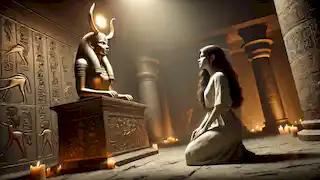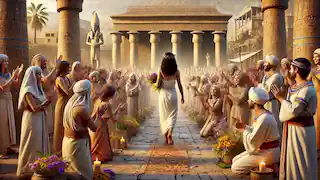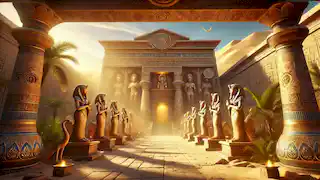In the golden sands of ancient Egypt, where the Nile River winds like a sacred ribbon through the desert, there lies a legend whispered through the ages. This is the tale of the goddess Hathor, a deity of love, joy, and protection, who once descended upon the earth to heal, to protect, and to restore peace in a time shrouded by chaos. Hathor’s story is woven with mystery, faith, and a touch of divine grace—a tale cherished by those who revere the goddesses of old, who are said to have walked among mortals and blessed the ancient world with their presence.
The legend begins in the sacred temple of Dendera, where the priests and priestesses tended daily to the goddess’s statue, believing her spirit dwelled within. There, on a day much like any other, a young priestess named Anuket was preparing for the daily rites when a strange occurrence foreshadowed a tale that would be passed down through generations. The temple was bathed in soft, golden light as dawn stretched across the ancient stones, casting long shadows that danced upon the walls. Anuket, a devout young woman with a heart as pure as the Nile’s waters, stood before the statue of Hathor. She whispered a prayer, her voice steady and reverent, as she lit the sacred incense and placed offerings of lotus flowers at the goddess’s feet. Suddenly, the flickering light of the candles seemed to grow brighter, illuminating the statue with an otherworldly glow. Anuket felt a shiver run down her spine, her pulse quickening as the air thickened with a sense of divine presence. She gasped as she realized she was no longer alone. A figure, radiant and graceful, emerged from the shadows—a woman with skin as smooth as polished stone and eyes filled with the wisdom of ages. This was no mere mortal; this was Hathor herself, descended from the heavens. Her headdress, adorned with cow horns and a solar disc, marked her as a goddess. Anuket fell to her knees, overcome by awe. Hathor spoke, her voice like the melody of a flute, soft yet powerful. “Rise, dear Anuket. Fear not, for I have come in a time of great need. Darkness stirs in Egypt, and I am here to bring light.” Hathor’s gaze softened as she touched Anuket’s shoulder, and in that instant, the young priestess felt a surge of strength and purpose flow through her. The goddess’s words echoed in her mind, filling her with an unshakable resolve. For generations, the people of Egypt had known Hathor as the goddess of love, fertility, and music, yet there was another aspect of her—one that emerged in times of dire need. Hathor, the avenger of chaos, the protector of the vulnerable, and the fierce warrior who would bring balance back to a world on the brink of turmoil. Days after Hathor’s vision, strange omens began to appear across the kingdom. Farmers reported that their livestock, normally calm and bountiful, had become restless, producing less milk and wandering away from their herds. In the markets, whispers spread of mysterious figures seen lurking in the shadows, eyes glowing in the darkness. The priests spoke of a prophecy foretelling a time of discord, a time when the goddess herself would have to intervene to restore order. Anuket traveled from Dendera to Thebes, seeking wisdom from the Oracle of Amun. The journey was long and treacherous, but she was driven by her devotion to Hathor and the belief that her goddess had chosen her for this task. Upon reaching the Oracle, she was greeted by an old priestess with eyes that seemed to peer into the soul. The Oracle spoke in riddles, as was her way. “In the heart of the desert lies the source of darkness, a creature born of shadows and hunger. Only the light of the goddess can drive it away, yet it will test the faith and strength of those who follow her.” Anuket listened intently, her heart pounding with both fear and anticipation. “Who is this creature?” she asked, her voice trembling. The Oracle gave no name but only gestured to the west, toward the endless expanse of desert where the sun set each night. There, she knew, was where her journey would lead. Anuket set forth, her heart steady with resolve. She was accompanied by a small band of loyal followers, each of whom carried a torch of Hathor’s flame, symbolizing their faith and dedication. They journeyed through the blistering heat, through sandstorms and desolate plains, until they reached the Valley of the Serpent—a place feared by all who knew its name. The air was thick with an unsettling silence, broken only by the occasional howl of the wind. As they descended into the valley, the darkness seemed to press upon them, thick and heavy. Anuket felt her torch flicker, and her heart skipped a beat as shadows danced on the valley walls, moving with a life of their own. A figure appeared in the distance—a beast with the body of a lion, the wings of a vulture, and eyes that glowed like molten gold. This was Apep, the chaos serpent, an ancient entity that had long dwelled in the underworld, thirsting for the light of the gods. With Hathor’s power in her heart, Anuket stepped forward, her voice strong as she called upon her goddess. “By the light of Hathor, I banish you back to the shadows!” she cried, raising her torch high. Her voice echoed through the valley, and in response, a blinding light burst forth, enveloping the creature. Apep roared in defiance, his claws raking at the air, but the power of Hathor was too strong. The light burned him, forcing him back into the darkness, where he vanished with a final, ear-piercing shriek. The valley fell silent once more, and Anuket collapsed to her knees, exhausted yet triumphant. She had faced the embodiment of chaos and emerged victorious. The journey back to Dendera was filled with a sense of relief and celebration. Word of Anuket’s bravery and Hathor’s blessing spread across Egypt, inspiring the people to renew their faith in the goddess. Temples were adorned with fresh flowers, and offerings of fruit and wine were laid at Hathor’s feet in gratitude for her protection. Anuket, now revered as a heroine, was greeted by the high priest of Dendera, who praised her courage and devotion. Yet Anuket remained humble, knowing that it was Hathor’s light that had guided her through the darkness. She dedicated her life to serving the goddess, teaching others of Hathor’s grace and strength, and reminding them that even in the darkest of times, the light of the goddess would always prevail. As the years passed, the story of Hathor’s descent became a cherished legend, told to children around campfires and sung in the great halls of Egypt. Anuket’s name was remembered alongside the goddess she served, her legacy woven into the tapestry of Egypt’s rich history. And so, the legend of the Hathor lived on, a testament to the power of faith and the enduring light of love and protection in the face of chaos.The Golden Vision of Hathor

The Omen in the Desert
The Desert Quest

The Return of Peace





















